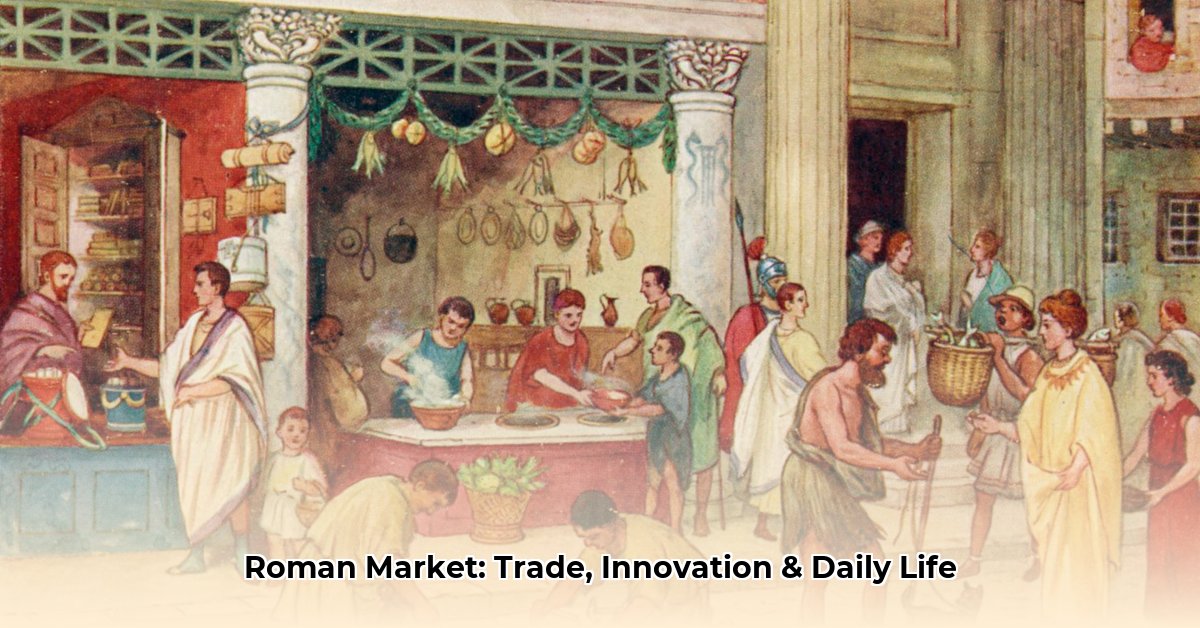Imagine stepping into the vibrant heart of an ancient Roman market. These bustling centers were far more than simple places of commerce; they were dynamic social hubs, crucibles of innovation, and vital engines of the Roman Empire. Iconic structures like Trajan’s Market, masterfully designed by Apollodorus of Damascus and completed around 113 AD, exemplify this sophisticated economic landscape. Seamlessly integrated into Rome’s Quirinal Hill with its terraced levels, grand arches, and vaulted ceilings, Trajan’s Market was a sprawling administrative, commercial, and public complex. Often described as the world’s first shopping mall, this notion captures only a fraction of its true multifaceted purpose.
You can explore more about the trade of ancient Rome in this resource. This comprehensive exploration delves into the intricate workings of these markets, examining the diverse goods exchanged, the astute regulations governing trade, the technological advancements that propelled their efficiency, and the significant challenges they encountered. We aim to illuminate how the profound ideas born within these ancient commercial hubs continue to shape contemporary business practices and urban design.
The Pulse of Roman Life: More Than Just Commerce
The world of the ancient Roman market was undeniably more than a simple venue for buying and selling; it served as a revealing window into the very fabric of Roman society. Picture the sensory overload: the vibrant chaos, the fervent calls of merchants, the complex scent of exotic spices mingling with local produce, and the clamor of thousands of daily interactions. From the sacred grounds of the Roman Forum, which served as the empire’s most important nexus for trade and government, to specialized marketplaces like the Forum Boarium for cattle and the Forum Holitorium for vegetables, these marketplaces profoundly influenced every facet of Roman existence. Cities outside the capital, such as Pompeii and Ostia, also boasted thriving markets that facilitated both local and long-distance trade, bringing goods from across the Mediterranean to Roman homes.
The Denarius and Diverse Goods: A Global Marketplace
At its zenith, Trajan’s Market exemplified Roman ingenuity, housing an estimated 150 shops (tabernae) and administrative offices across its multiple levels. This colossal structure reflected a sophisticated approach to retail and economic architecture. Merchants convened from every corner of the Roman Empire, bringing a staggering array of goods. From exotic spices, fine silks, and rare perfumes from the East to robust grains from Egypt, prized olives and wine from North Africa, and exquisite pottery and metals from Gaul, the markets offered a truly global selection. This immense flow of goods into dynamic centers bolstered the Roman Empire’s economy and enriched civilian life.
Payment primarily occurred using standardized coinage, with the silver denarius serving as a widely accepted currency for everyday transactions. However, for large-scale private contracts, significant land deals, or substantial tax payments, the rare and weighty aes grave, a form of cast bronze, was sometimes employed. This practice highlights a tiered monetary system where valuable bronze, silver, and gold coins circulated, reflecting the economic stratification within Roman society and the sophisticated means of exchange that enabled extensive commerce.
Governing the Agora: Regulation and Social Order
The ancient Roman market transcended its commercial function to become a pivotal social and political meeting point. Citizens gathered not solely for transactions but also to absorb political news disseminated through public pronouncements, exchange the latest gossip, and conduct personal affairs. It was, indeed, a crucial place “to see and be seen,” fostering community and a shared urban experience.
Recognizing their critical importance for both social cohesion and economic stability, the Roman government maintained stringent oversight over these marketplaces. Officials known as aediles diligently enforced regulations, ensuring the quality of goods, standardizing weights and measures, and actively preventing fraud. These vigilant market inspectors regularly patrolled stalls, ready to impose heavy fines on lawbreakers to uphold fair trade. The state’s involvement in economic affairs was deep, often taking proactive steps to regulate prices and trade practices. For instance, the Lex Aelia Sentia of 4 AD, while primarily pertaining to the manumission of slaves, also reflected broader legislative trends towards market stability, aiming to prevent monopolies and foster competitive practices by prohibiting merchant guilds from artificially setting prices. This robust governmental oversight was crucial for fostering trust among consumers and maintaining stability within the vast marketplace, ensuring a tangible degree of confidence in daily transactions for the average Roman citizen.
Roman Ingenuity: Technology Driving Trade
Technological innovation, seemingly rudimentary by modern benchmarks, played a pivotal role in the success and efficiency of the ancient Roman market system, profoundly impacting trade and economic growth across the vast empire.
The legendary Roman roads, a marvel of engineering, were not solely military arteries but indispensable conduits for the rapid and secure movement of commercial goods. This extensive network of paved roads, spanning over 250,000 miles, dramatically enhanced connectivity, reduced travel times, and expanded trade networks, allowing perishable goods to reach distant markets and facilitating the flow of raw materials to urban centers. Beyond infrastructure, innovations like watermills significantly accelerated the production of flour and other goods, boosting output and efficiency for merchants. The potter’s wheel revolutionized ceramics production, enabling mass manufacturing and wider distribution.
Furthermore, the development of sophisticated banking systems, including the use of argentarii (bankers) who offered loans, managed deposits, and facilitated transfers, streamlined economic operations. These early financial services provided a secure place for wealth and enabled complex commercial dealings. Standardized coinage, meticulously minted from various precious metals and in different denominations, along with carefully calibrated scales for weighing valuable commodities like gold and silver, further facilitated equitable and efficient exchange. These advancements underpinned unprecedented economic growth and fostered commercial trust throughout the empire.
The Fading Glow: Challenges and Decline
Even the highly sophisticated ancient Roman market system was not immune to the formidable internal and external pressures that eventually contributed to the decline of the Roman Empire, particularly during the turbulent third century AD. The very military apparatus that fueled Rome’s expansion also proved to be an insatiable drain on the treasury. Sustaining vast legions across an expansive empire was a continuous and crippling fiscal challenge.
To finance these immense expenditures, emperors, notably Nero and later others from the 3rd century crisis, resorted to severe currency debasement—progressively reducing the precious metal content, primarily silver, in coins. This fiscal manipulation triggered rampant inflation, as the purchasing power of the denarius plummeted, destabilizing the economic foundations of Roman society and eroding public trust in the currency. Diocletian’s infamous Edict on Maximum Prices (301 AD), an attempt to curb this rampant inflation, paradoxically led to widespread black markets and stifled legitimate trade, highlighting the perils of excessive state control over economic forces.
The Roman tax system, initially effective, evolved into an increasingly oppressive burden. Exorbitant taxes, particularly on productive citizens and landholders, spurred widespread evasion among the wealthy elite who often found mechanisms to protect their assets. Consequently, the tax burden disproportionately fell upon the lower classes, exacerbating their impoverishment and stifling economic initiative. The devastating Antonine Plague of the mid-2nd century and subsequent epidemics decimated the population, leading to severe labor shortages that disrupted both agricultural production and trade, adding another critical layer of complexity to the economic woes. The pervasive reliance on slave labor, while initially cost-effective, also suppressed technological innovation and hindered the economy’s long-term adaptability, as there was less impetus for advancements that would displace cheap labor.
The collapse of the Western Roman Empire was not a singular event but rather the culmination of interconnected stresses. Disrupted trade routes due to constant internal conflicts and relentless barbarian invasions, such as those by the Goths and Vandals, severely hampered commerce and the flow of goods. The increasing self-sufficiency of large rural estates (villae) also contributed to a decline in urban market activity, as fewer people relied on city markets for provisions. These multifaceted challenges faced by Roman markets—from military overspending and the direct impact of currency debasement to demographic shocks and the rise of localism—serve as a potent reminder of the fragility of even advanced economic systems when confronted with complex, interconnected pressures.
Enduring Legacy: Rome’s Blueprint for Modern Commerce
Despite the formidable challenges that ultimately contributed to its decline, the core principles and practices established in Roman markets left an indelible mark on Western commerce. Their pioneering emphasis on robust infrastructure, stringent regulation, and standardized practices continues to shape modern trade. The meticulous layout of contemporary shopping centers, with their organized zones for different goods and public gathering areas, subtly echoes ancient market design principles. The vital role of government agencies in ensuring fair trade, preventing monopolies, and protecting consumers—from consumer protection laws to financial regulations—finds its genesis in Roman governmental oversight of the fora.
The Roman genius for infrastructure, particularly roads, served as a blueprint for efficient transportation networks that are still critical for global trade today. Their advancements in banking, including practices like lending, managing deposits, and sophisticated financial record-keeping, laid foundational concepts for modern financial institutions. The standardization of coinage and the development of sophisticated weighing scales established enduring precedents for monetary systems and fair commercial measurement worldwide.
Understanding the intricate history of Roman markets—their innovations, their triumphs, and their eventual decline—offers critical perspectives that inform our present and future economic endeavors. For urban planners, studying the foundational design of Roman markets, such as Trajan’s Market, can inspire the creation of more dynamic, pedestrian-friendly urban spaces that naturally foster social interaction and stimulate local economic activity. For historians and economists, comparing Roman economic practices with modern ones reveals enduring patterns and divergences in commercial behavior, offering invaluable insights into the complex interplay of political, social, environmental, and economic factors that shape societies. The resonant echoes of the Roman forum can still be distinctly heard in the bustling marketplaces and sophisticated financial systems of today, serving as a powerful testament to their enduring influence.










